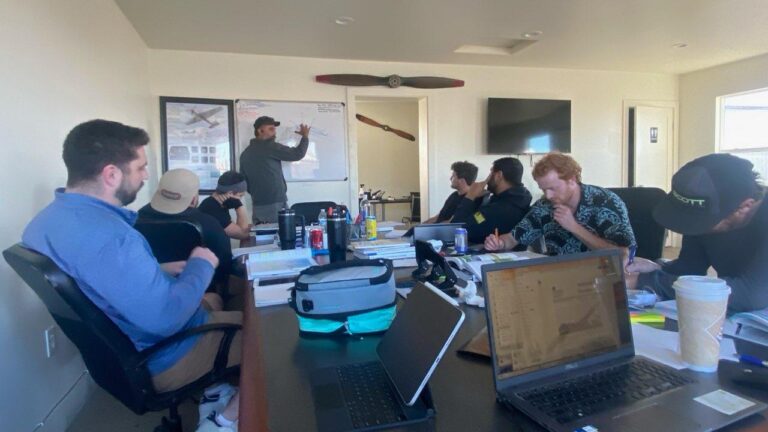TSA Flight Training Security Requirements — detailed guide (U.S. citizen vs non-citizen)
Below is a practical, detailed document you can give students and flight training providers. It explains who must get TSA approval, what the assessment looks like, what documents/steps are required, how long approvals last, provider responsibilities, disqualifying offenses, and helpful checklists.
Summary (short)
Non-U.S. citizens / non-U.S. nationals (including lawful permanent residents in many cases) who want to begin flight training in the U.S. must complete a TSA Security Threat Assessment (STA) under the Flight Training Security Program (FTSP) and receive a TSA Determination of Eligibility before starting training.
U.S. citizens and U.S. nationals generally do not need TSA FTSP clearance to undertake flight training. Flight providers must still follow FTSP record-keeping and security-awareness training rules.
Legal basis and program names
The program is now called the Flight Training Security Program (FTSP); it formalizes and replaces the Alien Flight Student Program (AFSP). The final rule took effect July 30, 2024. TSA+1
Primary regulations are in 49 CFR Part 1552 (FTSP) and related fingerprint/criminal-history rules in 49 CFR § 1544.229. Flight training providers and candidates should reference these when in doubt.
Who needs a TSA security threat assessment (STA) before starting flight training?
Must get STA (candidate)
Non-U.S. citizens / non-U.S. nationals who will receive flight training in the U.S. that is FAA-regulated (this includes private pilot, instrument, commercial, multi-engine, most initial ratings, and many recurrent trainings). The FTSP applies regardless of whether the training will result in an FAA certificate.
Generally exempt
U.S. citizens and U.S. nationals do not require FTSP/AFSP/TSA Determination of Eligibility to start flight training. (Flight providers still have regulatory obligations such as employee security awareness training and FTSP portal checks for FTSP-covered candidates.)
Note: Visa type matters for non-citizens. Certain visitor visas (e.g., B-1/B-2 tourist/business) often do not authorize FAA flight training — students must ensure their immigration status/visa allows training. TSA FTSP vetting includes an immigration check.
What the TSA security threat assessment includes (what TSA checks)
When you apply for an FTSP STA, TSA conducts, at minimum:
Identity confirmation (documents, biographic checks).
Immigration status check (visa, lawful presence, eligibility to remain/train in U.S.).
Checks of terrorist watchlists and other federal databases to determine if candidate poses a security threat.
FBI fingerprint-based criminal history records check (CHRC) to identify disqualifying criminal offenses listed in 49 CFR § 1544.229(d).
TSA may request clarifying information if records are incomplete or if a criminal history appears. Candidates may be able to correct inaccurate records (see “Correcting/calling errors” below).
Typical application steps for a non-U.S. citizen candidate
(Providers usually help start the process through the FTSP portal; exact portal flows can change.)
Provider creates candidate entry via the FTSP/FTS portal (flight training provider must register and designate a Security Coordinator in the portal). Provider confirms they will sponsor/endorse candidate to apply.
Candidate submits application in the FTSP portal (biographic info, identity documents, passport, visa information, current address, etc.). FTSP web portal/URL is the place to apply.
Fingerprinting / FBI CHRC — candidate provides fingerprints (electronic) as required for the FBI CHRC. TSA will use the fingerprints to run the criminal history check. Some providers arrange an appointment for fingerprinting (local vendor/NBIS).
Fee payment — an STA fee is charged; amount & method are posted in the FTSP guidance (fees may change).
TSA adjudication — TSA completes identity/immigration/terrorist watchlist/CHRC checks and issues a Determination of Eligibility (approved) or Determination of Ineligibility / Deny Candidate (if security concerns or disqualifying conviction). This decision is communicated to the provider via the FTSP portal.
Training may begin only after provider confirms the TSA Determination of Eligibility in the FTSP portal. If TSA issues a Determination of Ineligibility, training must not start and the provider must follow instructions in the rule.
How long the TSA Determination of Eligibility lasts
Determination of Eligibility typically expires 5 years after issuance unless earlier revoked for a disqualifying criminal conviction or other reasons. TSA may also perform recurrent vetting during that time.
Disqualifying criminal offenses (high-level)
TSA uses the list of disqualifying crimes in 49 CFR § 1544.229(d). Examples include (this is not exhaustive — see the regulation):
Aircraft piracy, interference with flight crew, carrying a weapon/explosive aboard an aircraft, forgery of aviation certificates, improper transportation of hazardous materials, and other serious aviation- or security-related felony offenses. A full list is in the regulation. A conviction within 10 years (or as defined by the rule) may be disqualifying.
If a candidate’s FBI record indicates a disqualifying conviction, TSA (and providers) follow the administrative process; the candidate can attempt to correct inaccurate records with local jurisdictions / the FBI if they believe the record is wrong.
Provider responsibilities (what flight schools/instructors must do)
Key responsibilities under 49 CFR Part 1552 include:
Designate a Security Coordinator and register provider in the FTSP Portal.
Verify, via the FTSP Portal, that each non-citizen candidate has received a TSA Determination of Eligibility before allowing training to begin. Do not begin training without confirmation.
Provide security awareness training to employees who have direct contact with flight students; maintain records of that training. TSA requires initial and recurrent security awareness training for applicable staff.
Notify TSA via the FTSP Portal if the provider becomes aware a candidate is involved in alleged disqualifying crimes, is no longer permitted to remain in the U.S., or otherwise poses a security threat.
Providers often assist international students with the FTSP sign-up, fingerprint logistics, and document submission. Expect providers to collect copies of passport/visa/ID to upload to the FTSP portal.
Practical timelines & what to tell students
Typical adjudication time: Many providers and aviation schools report the FTSP/AFSP checks often complete in days to a few weeks for straightforward cases, but times vary and delays happen if TSA needs clarification or if criminal/immigration checks return issues. The final rule streamlined processes, but exact timing is case dependent. Plan ahead — don’t expect same-day clearance.
Validity: Once issued, a Determination of Eligibility usually remains valid up to 5 years, unless revoked for a disqualifying conviction or security reason.
Correcting errors & appeals
If the FBI CHRC or other records show a criminal history that the candidate believes is inaccurate, the candidate may work to correct the record (local court/jurisdiction → FBI) and provide corrected documentation to TSA/provider. See 49 CFR § 1544.229 and FTSP candidate guidance for the administrative steps.
If TSA issues a Determination of Ineligibility, the candidate may be informed of the reason and any available redress/appeal or correction paths; some cases may be appealed through administrative processes or require record corrections.
Frequently asked practical questions
Q: Do U.S. citizens ever need FTSP checks?
A: No — U.S. citizens and U.S. nationals generally do not need FTSP clearances to begin flight training. However, specific employer/contract or aircraft type rules (e.g., training on certain government aircraft or special programs) might impose additional requirements — check with the provider. Provider must still comply with FTSP program rules for non-citizen candidates.
Q: Which trainings trigger FTSP?
A: Initial airman certificates and many initial ratings (private, commercial, instrument, multi-engine) and certain recurrent training are commonly covered. FTSP guidance and provider guides list covered activities — assume the rule applies to most formal FAA-regulated training for non-citizens.
Q: What documents should a non-citizen student have ready?
A: Valid passport, U.S. visa/immigration documents (if applicable), previous passports/immigration history as requested, current contact info, and ability to get electronic fingerprints. The provider will advise exact upload requirements.
Candidate checklist (non-U.S. citizens)
Confirm your visa/status allows flight training in the U.S. (consult immigration counsel if unsure).
Contact your flight training provider and ask them to enter you into the FTSP portal / advise how to apply.
Gather documents: passport, visa, I-94 (if applicable), prior passports/entry stamps, current address, contact email/phone.
Complete FTSP application, pay required fee, and complete electronic fingerprinting when instructed.
Await TSA Determination of Eligibility. Do not start training until your provider confirms the TSA approval in the FTSP portal.
Provider checklist (flight schools)
Register in the FTSP Portal, designate a Security Coordinator, and maintain current FTSP portal account details.
Ensure staff with direct student contact complete security awareness training and retain records.
Enter candidate information in the FTSP portal, verify candidate identity/documents, and confirm TSA Determination of Eligibility before training starts.
Monitor and report to TSA any suspected disqualifying offenses or immigration status changes for candidates.
Official resources (start here)
TSA FTSP press release and program overview (TSA). TSA
49 CFR Part 1552 — Flight Training Security Program (regulatory requirements for providers and candidates).
49 CFR § 1544.229 — List and rules for disqualifying criminal offenses; fingerprint-based CHRC details.
FTSP Candidate & Provider guides and TSA FTSP portal (TSA / FTSP portal pages; providers often publish their own “how to” guidance).
Last words / practical advice
Start the FTSP process early if you’re a non-U.S. citizen — plan weeks in advance to avoid training delays.
Providers typically assist with the FTSP portal, but the candidate must supply accurate documents and complete fingerprinting.
If there are criminal history questions on your record, begin record-correction steps early (local court → FBI) because CHRC issues cause the most delays.







